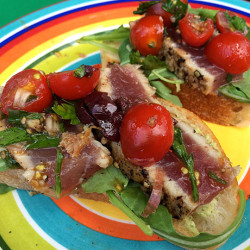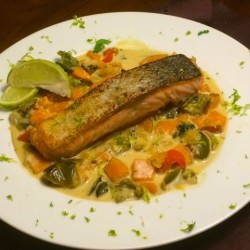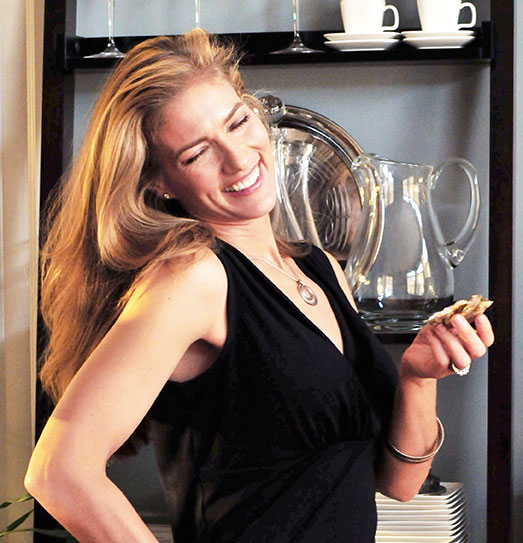Saturday, December 13, 2014
This is the first part of a three-part series on this dish. For the recipe itself, click here.
What happens when you sear up a gorgeous piece of tuna with black pepper, Fleur de Sel, and sesame seeds and serve it with satay sauce and a crunchy radish garnish? This. This bite of deliciousness right here, which sorta looks like my spoon for the “Under the Sea” challenge on The Taste.
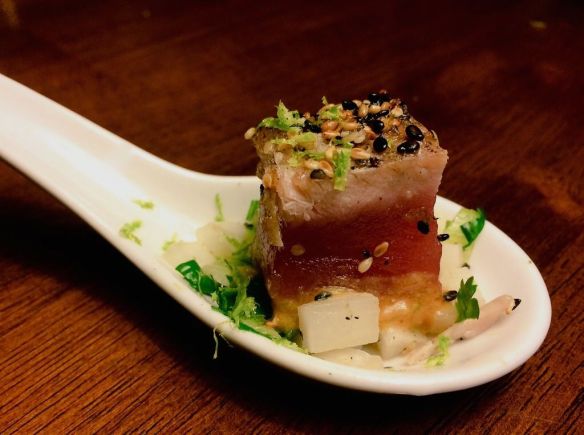
So why did I make this dish? For starters, the logistics of the competition were paramount considerations, which involve timing and strategy. Is it circa 1998, as Chef Marcus Samuelson claimed? Perhaps. Whatever. The name of the game is to stay in the game, so I didn’t want to take big risks with one of my more inventive dishes, like, say, seared scallops with Moroccan spices and red lentils or swordfish with tomato tamarind sauce and coconut chutney. Seared tuna is also extremely quick to cook: a crispy crust with a rare center and it’s done. My Asian-inspired peanut sauce is, frankly, awesome—and takes experience to prepare with its many ingredients. I began making my own after eating a lot of bad Thai takeout, drawing on skills I learned in a cooking class in Thailand using traditional seasonings like Nam Pla. Finally, my crisp radish salad with its flavorful dressing brought in a creative element, a burst of acidity that perfectly balanced the richness of the fish and sauce. In fact when I remade this dish for today’s post, I found it didn’t even need the satay sauce at all. If I had to do it again on primetime I’d leave it off and focus on the radishes. Then again, I’m a radish fiend.
Beyond all that, tuna is one seriously nutritious fish, a protein powerhouse that’s packed with essential omega-3 fatty acids like EPA and DHA that have anti-inflammatory actions critical for heart- and brain health. And most people, including pregnant women and children, don’t consume the recommended levels for optimal development and disease prevention. Tuna is also an amazing source of selenium and vitamins B-3, B-12, B-6, and D; B-12 is particularly important since many adults are at risk of deficiency, especially those over 50 years of age. For all these reasons and more, most people would benefit from increasing their consumption of seafood.
On the other hand, tuna is high on the food chain and can be contaminated with methylmercury. Other species suffer from dwindling populations due to severe over-fishing, and bycatch compromises other sea life. And there are a whole bunch of different species of tuna that vary on these factors.
 It gets to be a lot, I know, but there is good science to guide you. The Monterey Bay Aquarium Seafood Watch has a great app that informs decision-making when standing at the fishmonger’s counter—yes, I’m that person—and the National Oceanic and Atmospheric Administration Fishwatch is also quite informative; a recent article in National Geographic summarizes the myriad tuna issues. If you’re interested in this kind of farm-to-fork thinking when making food choices please subscribe to my blog. You might also enjoy my recent book, National Geographic Foods for Health, currently on sale at local bookstores and here.
It gets to be a lot, I know, but there is good science to guide you. The Monterey Bay Aquarium Seafood Watch has a great app that informs decision-making when standing at the fishmonger’s counter—yes, I’m that person—and the National Oceanic and Atmospheric Administration Fishwatch is also quite informative; a recent article in National Geographic summarizes the myriad tuna issues. If you’re interested in this kind of farm-to-fork thinking when making food choices please subscribe to my blog. You might also enjoy my recent book, National Geographic Foods for Health, currently on sale at local bookstores and here.
And just for the record, the other elements I included in the dish, like radishes, sesame seeds, and peanut butter, are pretty darn healthful, too.
So. Cooking and Eating the PK Way. Better for you, better for the planet, and unbelievably tasty when dishes like sesame-crusted tuna with satay sauce and radish salad are on the menu.
What else can I tell you, really?
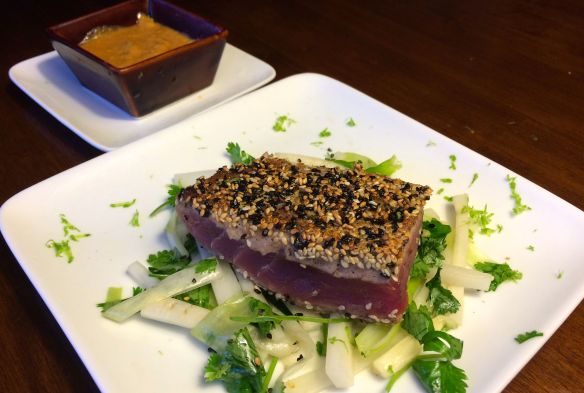
Oh, right.
The recipe.

